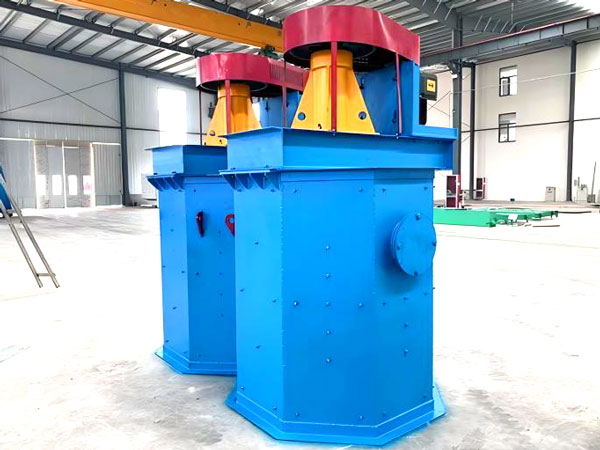6 ways remove Fe weak-magnetic from quartz silica sand
1. Mechanical cleaning and scrubbing to remove iron.
By using the mechanical external force of the Attrition cells scrubbers and the collision and friction between sand and gravel, the thin film iron on the mineral surface and the iron containing impurities adhered to the mineral surface are separated.
It is generally believed that the factors affecting the scrubbing effect mainly come from the structural characteristics and configuration of the mechanical scrubbing machine, followed by process factors, including scrubbing time and concentration

2. Magnetic method to remove iron
The minerals containing iron in quartz sand include hematite, limonite, magnetite, goethite, etc. Most of them are magnetic substances that can be magnetized under a magnetic field. During the magnetic separation process, utilizing this characteristic difference, a magnetic separator is used to remove these iron containing impurity minerals from quartz sand.
3. Flotation method to remove iron
Quartz sand iron removal flotation is mainly used to separate feldspar from quartz sand, but it can also be used to remove clay minerals such as mica and secondary iron from quartz sand.
Use hydrofluoric acid as an activator and amine cation collector for flotation under strong acidic conditions (pH 2-3).
4.Acid leaching method for iron removal
Acid leaching of iron is achieved by utilizing the characteristic that quartz is insoluble in acid (except HF) and Fe containing impurity minerals can dissolve in acid solution, thus achieving the goal of removing iron containing minerals from quartz sand. Acid leaching has a good removal effect on non-metallic impurities in quartz, in addition to iron minerals in quartz sand. Generally, sulfuric acid, hydrochloric acid, nitric acid, and hydrofluoric acid are expensive and have a significant impact on the environment. The reaction between oxalic acid and Fe3+on the surface of particles generates a complex, which is then dissolved in water to achieve the purpose of iron removal. However, in this case, the dissolution mechanism is different from that of inorganic acids on iron minerals.
5. Ultrasonic to remove iron
Ultrasonics is a high-frequency (frequency greater than 20000 Hz) sound wave that relies on medium propagation. It has mechanical energy and interacts with the medium during propagation, producing mechanical effects Thermal effect and hole effect. When ultrasound is discharged from water (or solution), a large number of compression and expansion zones are generated, causing countless microbubbles (bubbles) to form and rupture. This phenomenon is called cavitation. When a bubble forms, the pressure inside the liquid undergoes a sudden change, accompanied by a shock wave that generates thousands to tens of thousands of atmospheres. When subjected to impact, iron containing impurities attached to the surface of particles will detach from the particle surface and enter the liquid phase, thereby achieving the purpose of iron removal.
6. Microbial methods for iron removal
Microbial leaching or impregnation treatment of quartz sand surface is a recently developed iron removal technology, which is still in the stage of indoor and small-scale research. Research results both domestically and internationally have shown that using Aspergillus niger, Penicillium, Trichoderma viride, and other microorganisms to leach iron oxide from quartz surfaces can achieve good results. At the same time, using pre cultivated bacterial strains and mold culture media also results in a higher leaching rate of iron. Anaerobic bacteria decompose iron at a slower rate than aerobic bacteria. During bacterial leaching, the dissolution rates of various minerals are different. The iron dissolution rate in limonite is slower than that in goethite, but much higher than that in hematite.
Related:








Send Message
Please write down your requirement and contact details in the following form. You can also send a message to us by this email sales@staurk.com, we will reply to you within 24 hours.